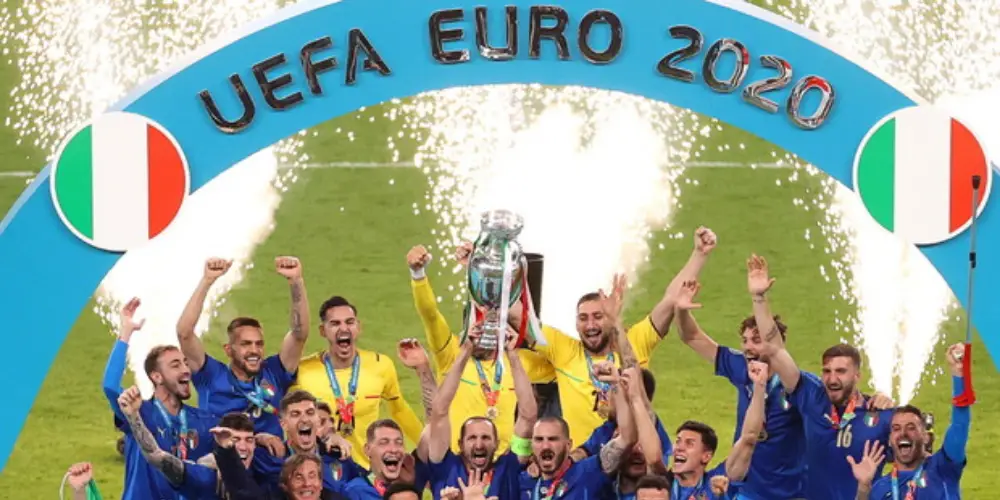Like many countries around the globe, Italy have become encapsulated the game we call football. Not only are the Italy national team known as one of the best teams of all time, but the Serie A home some of the classiest teams on earth.
When you think of Italy, you think of the wine, the belting sunshine, heaps of carbohydrates but most importantly, you think of the countless years of awe-inspiring football.
The Italy national team, commonly known as Azzurri, are the second-most decorated national outfit in the world and have homed some of the world’s best players. Roberto Baggio, Fabio Cannavaro, Franco Baresi, Paolo Maldini, Alessandro Del Piero, Dino Zoff – the list continues, but something instantly sticks out. Italy’s greatest ever players consist of many defenders. I wonder why.
Early forms of football in Italy
The Italian-style football we all know and love to this day went through an extensive tried and tested method before it arrived at its current form.
Harpastum began the country’s revolution and was played during the Roman Empire area, though the Romans also referred to it as small ball game. In terms of the ruling, little is understood around this area. The common understanding around football’s earliest form is that it consisted of violence with players seldom ending up being floored. Due to the rapid expansion of the famous Empire, it is believed that Italy’s version of the sport was heavily influential throughout the continent.
Another of the game’s ancestors is Calcio Fiorentino, which was a brutal sport originating in the Middle Ages. Nowadays, it looks more like a form of mixed martial arts, religious ceremony and rugby for than modern football. But trial and error is a beautiful part of life and is what make the modern aspects of sport – and in this particular case football – so enjoyable.
Turin and Genoa
It all has to start somewhere, right?
However, the game as we know and love it now arrived on the shores of Italy in the 1880s, all thanks to Edoardo Bosio. He was a merchant worker in the British textile industry and had spent years of his life in England, which is where he became familiar with trials and tribulations of football. Upon his 1887 return to Turin, his dream was to spread the revolution that was The Beautiful Game with the rest of his country and as such, founded the first Italy-based football club.
Torino Football and Cricket Club was the name, though Nobili Torino soon followed in the same year. However, in 1891, the two aforementioned clubs opted to combine forces and merge to become Internazionale Football Club Torino.
A two-year period between 1895 and 1897 was when the earliest tournaments began to form. A year later in 1898, the new federation, named Italian Football Federation (FIGC) was devised and its HQ was originally set in Turin. It was all coming together, and quickly.
FIGC’s first order of business upon its inception was creating the Italian Football Championship which involved four founding clubs: Genoa, FBC Torinese, Ginnastica Torino and Internazionale Torino, with the former winning its inaugural competition in 1898.
Following was a tournament named Prima Categoria, which was – unusually in today’s day and age – structured by regional groups. Winners of each group would then compete in a playoff in order to be declared champions. Genoa, unsurprisingly, were at the summit of the competition until 1904 as they won six titles in seven years.
The Italianisation and the “split of the Championship”
Way back in November 1907, the FIF (Federazione Italiana del Football) split the championships into two.
The Italian Championship was the staple tournament where the players were purely Italian, whereas the sister tournament called the Federal Championship allowed foreign players, too, to compete.
But why you ask?
Weaker clubs – composed of pure Italian teams – were, therefore, more likely to win a national title and, in turn, relegate those who had ‘foreigners’ playing for them. As a way of protest, the majority of big clubs, namely Genoa, Torino and Milan, withdrew from both competitions. In the first season, Juventus won the Federal Championship against Doria, while Pro Vercelli triumphed in the all-Italian domestic competition.
In 1909, the ‘bigger’ clubs devised a plan. They would only withdraw from the Italian Championship in order to shine a light on the ‘lesser’ tournament. The tables had, therefore, turned as Pro Vercelli triumphed US Milanese in the final of the Federal Championship, while Juventus filled their shoes by winning the Italian Championship.

In an obscene turn of events, the dissenters’ idea came to fruition.
As the Italian Championship – won by the Old Lady – diminishes into nothing, the winners of the Federal Championship, Pro Vercelli, became the “Campioni d’Italia 1909”.
Once again, for the 1909-10 campaign, it was changed to be played in a league format. A total of nine clubs were involved and each played both a home and away fixture. However, while some thought the notion of two separate tournaments was abolished, two titles were still awarded at the end of each season, though the Federal Championship had now taken the top spot.
Italian catenaccio
Catenaccio – the art of defending. It’s football in its finest form.
Football around the globe more often than not has a hard focus on creating chances, skills at the summit of the pitch and scoring goals, but not the Italians. Instead, they are most renowned for their defending.
However, it was not those in the culture-filled country of Italy that invented the system – it was Austrian coach Karl Rappan, who coached the Switzerland national team in the 1930s and 40s. Rappan’s ‘verrou’ system consisted of a defensive sweeper that operated just ahead of the goalkeeper.
Hailed as the man who trajected Catenaccio into its finest form was Helenio Herrera in the 1960s. In charge at Inter Milan, Herrera’s blueprint revolved around a watertight defence that limited the opposition to a large extent.
Herrera fell behind his rivals AC Milan and switched towards a more defensive-minded mindset, but little did he know of the effect his ways would have in years to come. Armando Picchi, his dedicated skipper, was often deployed as the sweeper behind the four-man defence. Going forwards, Inter won three Serie A titles, two European and another two Intercontinental Cups and, therefore, the system paid dividends. No constraints were held against the top half of the pitch either as they finished top scorers of their two title-winning seasons.
Nowadays, the Italian Catenaccio approach is typically non-existent due to the progression in attacking football. Once, the aim was to keep a clean sheet, whereas it’s all about goals, goals, goals.
The Seven Sisters
Once upon a time, there was romantic football!
The Serie A – and to an extent, world football – back in the 90s era was dominated by talk of La Sette Sorelle or – more commonly known – The Seven Sisters. But which teams form(ed) this iconic group?
Juventus, Roma, Fiorentina, Lazio, the Milan-based pair and Parma were the original seven, but the latter has since been replaced by Napoli, a team who defied all odds to win the most recent Scudetto. They almost become encapsulated in their own exclusive league, a league in how much a player costs has little substance.
Between a 30-year period between 1980 and 2010, the seven-outfit collective won a staggering 49 national titles and achieved a level of success that is typically unheard of, though their dominance on a global scale has not increased nor plateaued, but instead taking quite the hit.
In recent seasons we have seen some sort of remontada of this well-known phenomenon with the majority of the group-dwellers competing at the top of Europe. It’s a good thing for Italian football, of course, as he helps stabilize the Serie A at the summit of European football but from a socialist perspective, it does.
Italian dominance
Italy in a domestic sense, behind Spain, are the most trophy-ladened country in the world. There was a time where Italian teams were at the upper echelons of world football. Serie A, one of the top leagues in the world, is often depicted as the most tactical league thanks to its water-tight defensive work and their exciting attacking further up the pitch.
Most notable about the Italian national team – other than its close bond with defending – is its fabled No 10 jersey. What a number.
Some of the most successful – and influential – Italian names have donned the sacred number over the years and the number has often been given to some of the nation’s most talented assets. The fanbase are almost to thank for this as they dread to let it die a slow death as it helps to boost its popularity, but also streams of revenue – in one way or another.
Roberto Baggio spring to mind. Joint-fourth goals for Italy in the decorated history and is best remembered for his extravagant haircut.
Italy are a nation that will prevail the test of time, thanks to their revolutionary methods of defending and plethora of spellbinding talent. And maybe – just maybe – their food and drink is something to win over the fans, too!






